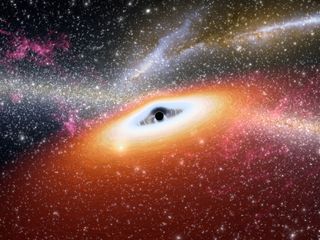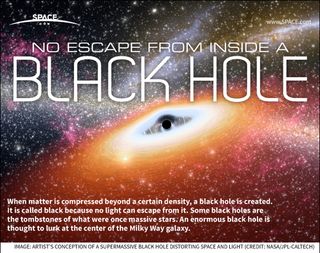What happens if a person goes into a black hole?
Black holes are some of the strangest and most fascinating objects found in outer space. They are objects of extreme density, with such strong gravitational attraction that even light cannot escape from their grasp if it comes near enough. Read on for black hole facts
Albert Einstein first predicted black holes in 1916 with his general theory of relativity. The term "black hole" was coined in 1967 by American astronomer John Wheeler, and the first one was discovered in 1971.
There are three types: stellar black holes, supermassive black holes and intermediate black holes.
Stellar black holes — small but deadly
When a star burns through the last of its fuel, it may collapse, or fall into itself. For smaller stars, up to about three times the sun's mass, the new core will be a neutron star or a white dwarf. But when a larger star collapses, it continues to compress and creates a stellar black hole.
Black holes formed by the collapse of individual stars are (relatively) small, but incredibly dense. Such an object packs three times or more the mass of the sun into a city-size range. This leads to a crazy amount of gravitational force pulling on objects around it. Black holes consume the dust and gas from the galaxy around them, growing in size.
According the Harvard-Smithsonian Center for Astrophysics, "the Milky Way contains a few hundred million" stellar black holes.
Supermassive black holes — the birth of giants
Small black holes populate the universe, but their cousins, supermassive black holes, dominate. Supermassive black holes are millions or even billions of timesas massive as the sun, but have a radius similar to that of Earth's closest star. Such black holes are thought to lie at the center of pretty much every galaxy, including the Milky Way.
Scientists aren't certain how such large black holes spawn. Once they've formed, they gather mass from the dust and gas around them, material that is plentiful in the center of galaxies, allowing them to grow to enormous sizes.

Illustration of a young black hole, such as the two distant dust-free quasars spotted recently by the Spitzer Space Telescope. More photos of black holes of the universe
(Image: © NASA/JPL-Caltech)
Supermassive black holes may be the result of hundreds or thousands of tiny black holes that merge together. Large gas clouds could also be responsible, collapsing together and rapidly accreting mass. A third option is the collapse of a stellar cluster, a group of stars all falling together.
Intermediate black holes — stuck in the middle
Scientists once thought black holes came in only small and large sizes, but recent research has revealed the possibility for the existence of mid-size, or intermediate, black holes (IMBHs). Such bodies could form when stars in a cluster collide in a chain reaction. Several of these forming in the same region could eventually fall together in the center of a galaxy and create a supermassive black hole.
In 2014, astronomers found what appeared to be an intermediate-mass black hole in the arm of a spiral galaxy.
"Astronomers have been looking very hard for these medium-sized black holes," co-author Tim Roberts, of the University of Durham in the United Kingdom, said in a statement.
"There have been hints that they exist, but IMBH's have been acting like a long-lost relative that isn't interested in being found."
Black hole theory — how they tick
Black holes are incredibly massive, but cover only a small region. Because of the relationship between mass and gravity, this means they have an extremely powerful gravitational force. Virtually nothing can escape from them — under classical physics, even light is trapped by a black hole.
Such a strong pull creates an observational problem when it comes to black holes — scientists can't "see" them the way they can see stars and other objects in space. Instead, scientists must rely on the radiation that is emitted as dust and gas are drawn into the dense creatures. Supermassive black holes, lying in the center of a galaxy, may find themselves shrouded by the dust and gas thick around them, which can block the tell-tale emissions.
Sometimes as matter is drawn toward a black hole, it ricochets off the event horizon and is hurled outward, rather than being tugged into the maw. Bright jets of material traveling at near-relativistic speeds are created. Although the black hole itself remains unseen, these powerful jets can be viewed from great distances.
Black holes have three "layers" — the outer and inner event horizon and the singularity.
The event horizon of a black hole is the boundary around the mouth of the black hole where light loses its ability to escape. Once a particle crosses the event horizon, it cannot leave. Gravity is constant across the event horizon.
The inner region of a black hole, where its mass lies, is known as its singularity, the single point in space-time where the mass of the black hole is concentrated.
Under the classical mechanics of physics, nothing can escape from a black hole. However, things shift slightly when quantum mechanics are added to the equation. Under quantum mechanics, for every particle, there is an antiparticle, a particle with the same mass and opposite electric charge. When they meet, particle-antiparticle pairs can annihilate one another.
If a particle-antiparticle pair is created just beyond the reach of the event horizon of a black hole, it is possible to have one drawn into the black hole itself while the other is ejected. The result is that the event horizon of the black hole has been reduced and black holes can decay, a process that is rejected under classical mechanics.
Scientists are still working to understand the equations by which black holes function.
Shining light on binary black holes
In 2015, astronomers using the Laser Interferometer Gravitational-wave Observatory (LIGO) made the first detection of gravitational waves. Since then, the instrument has observed several other incidents. The gravitational waves spotted by LIGO came from merging stellar black holes.
"We have further confirmation of the existence of stellar-mass black holes that are larger than 20 solar masses — these are objects we didn't know existed before LIGO detected them," MIT's David Shoemaker said in a statement. Shoemaker is the spokesperson for the LIGO Scientific Collaboration (LSC), a body of more than 1,000 international scientists who perform LIGO research together with the European-based Virgo Collaboration.
Advertisement
LIGO's observations also provide insights about the direction a black hole spins. As a pair of black holes spirals around one another, they can spin in the same direction or they can be completely different.
"This is the first time that we have evidence that the black holes may not be aligned, giving us just a tiny hint that binary black holes may form in dense stellar clusters," said LIGO researcher Bangalore Sathyaprakash of Penn State and Cardiff University.
There are two theories on how binary black holes form. The first suggests that they formed at about the same time, from two stars that were born together and died explosively at about the same time. The companion stars would have had the same spin orientation, so the black holes they left behind would, as well.
Under the second model, black holes in a stellar cluster sink to the center of the cluster and pair up. These companions would have random spin orientations compared to one another. LIGO's observations of companion black holes with different spin orientations provide stronger evidence for this formation theory.
"We're starting to gather real statistics on binary black hole systems," said LIGO scientist Keita Kawabe of Caltech, who is based at the LIGO Hanford Observatory. "That's interesting because some models of black hole binary formation are somewhat favored over the others even now and, in the future, we can further narrow this down."
Interesting facts about black holes
- If you fell into a black hole, theory has long suggested that gravity would stretch you out like spaghetti, though your death would come before you reached singularity. But a 2012 study in Nature suggests that quantum effects would cause the event horizon to act much like a wall of fire, instantly burning anyone to death.
- Black holes do not "suck." Suction is caused by pulling something into a vacuum, which the massive black hole definitely is not. Instead, objects fall into them.
- The first object considered to be a black hole is Cygnus X-1. Rockets carrying Geiger counters discovered eight new X-ray sources. In 1971, scientists detected radio emissions coming from Cygnus X-1, and a massive hidden companion was found and identified as a black hole.
- Cygnus X-1 was the subject of a 1974 friendly wager between Stephen Hawking and a fellow physicist Kip Thorne, with Hawking betting that the source was not a black hole. In 1990, he conceded defeat.
- Miniature black holes may have formed immediately after the Big Bang. Rapidly expanding space may have squeezed some regions into tiny, dense black holes less massive than the sun.
- If a star passes too close to a black hole, it can be torn apart.
- Astronomers estimate there are anywhere from 10 million to a billion stellar black holes, with masses roughly three times that of the sun, in the Milky Way.
- The interesting relationship between string theory and black holes gives rise to more types of massive giants than found under conventional classical mechanics.
- Black holes remain terrific fodder for science fiction books and movies. Check out the science behind the movie "Interstellar," which relied heavily on theoretical physicist Kip Thorne to bring real science to the Hollywood feature. In fact, work with the special effects of the blockbuster lead to an improvement in the scientific understanding of how distant stars might appear when seen near a fast-spinning black hole.

No comments:
Post a Comment